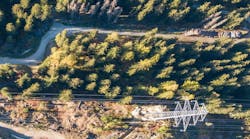Overall what utility vegetation managers need from utility regulators consists of a truthful assessment of the current level of VM expertise among regulatory staff, which may require as an a priori condition, a more extensive education in VM, a willingness to contract expertise to fill voids and a recognition that the role of regulator is protecting the ratepayer. In this article I will attempt to provide an overview of the key issues.
Probably the first issue can be phrased as “you don’t know what you don’t know.” However, a recognition or admission of this current state of knowledge would or should lead to actions that are different from the current norm. Once again, I’ll ask some questions. As a regulator have you contracted management performance audits of utilities? For the investigated utilities, were trees one of the primary outage causes? Have you contracted audits of utilities after major storms where trees were the primary outage cause? Did you request or ensure that the bidders would provide expertise in utility VM? Did you or should you give preference to more expensive bids containing such expertise even though it was not specifically requested? If you did not ask for utility VM expertise, did you arrive at this decision after communicating with regulatory staff in other jurisdictions that have been recipients of such expertise and were able to inform you regarding their perceived value of this expertise and the resultant changes in tree-related outages?
For those who have some familiarity with utility VM, having spent time in the field looking at vegetation in proximity to power lines and given consideration to avoiding tree-conductor conflicts, I can provide a substantive education. It will, however, require a considerable time commitment as it is necessary to follow the links to all the referenced articles.
The first thing we need is a common language. I’ve set that out in a previous article, Vegetation Management Terms. This article is a glossary of sorts for utility vegetation management. It provides a foundation of distinctions without which one does not have the conceptual tools necessary to penetrate the issues in utility vegetation management and thereby assess what constitutes true tree-related outage mitigation. The lack of this common language and the resultant lack of clarity have led to utility regulators in a number of states setting “tree trimming” cycles. “Tree trimming” may be viewed as most closely relating to tree pruning. If one is conversant with how trees cause outages, which on distribution systems is rarely by a phase-to-ground fault, but rather by phase-to-phase faults or by breaking the continuity of the circuit, it should be apparent that pruning for clearance between trees and conductors will have a minimal impact on future storm damage. It’s possible that increasing tree-conductor clearance will avoid the wind whipping of trees into a conductor so that it slaps another conductor resulting in a phase-to-phase fault. However, if this were the major mode of storm damage, restoration would be far simpler than it is, as all that would be required is a resetting of the protective device. So in addition to a common language we also require a common understanding of how trees cause outages.
While the pruning of trees will contribute little to improving reliability, the pruning program tends to be one of the major VM expenses. Consequently, when regulators set the length of the “tree trimming” maintenance cycle, there is considerable risk that ratepayer costs have been unrewardingly increased as funds are directed to pruning more trees per annum. However, this pruning will not decrease storm damage nor noticeably improve reliability. If there is a reliability benefit, it arises from the fact that the hazard tree maintenance cycle has been simultaneously shortened. Why not direct funding specifically and exclusively to the operations that produce the desired outcome?
In Part 3 we will discuss the evaluation of maintenance cycles and that shorter maintenance cycles may or may not improve reliability.

